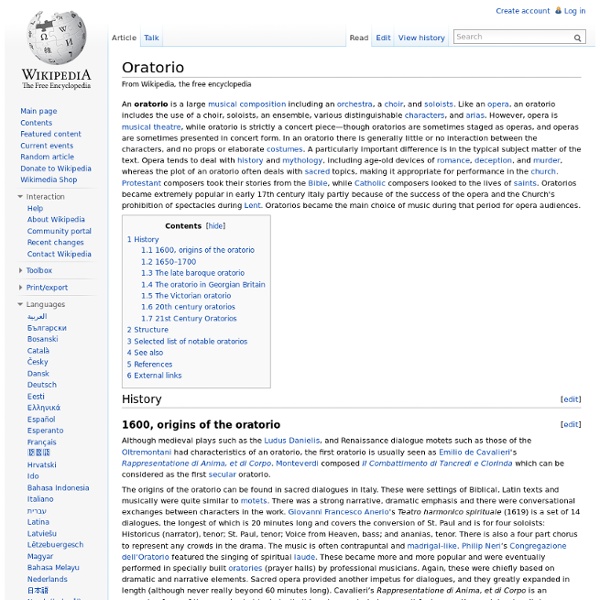Carl Maria von Weber
Carl Maria von Weber Carl Maria Friedrich Ernst von Weber (18 or 19 November 1786 – 5 June 1826[1]) was a German composer, conductor, pianist, guitarist[2] and critic, one of the first significant composers of the Romantic school. Weber's contribution to vocal and choral music is also significant.
The Oratorio - History and Composers of Oratorios
Characteristics of the Oratorio An oratorio is an extended composition for vocal soloists, chorus and orchestra; the narrative text is usually based on scripture or biblical stories but is non-liturgical. Although the oratorio is often about sacred subjects, it may also deal with semi-sacred subjects. This large-scale work is often compared to an opera, but unlike the opera, the oratorio often doesn't have acting, costumes and scenery.
The Oratorios of Handel
Background The Italian Baroque oratorio was hardly anything other than an opera on a sacred subject, presented in concert instead of on the stage. This conception is an essential element of Handel's oratorios. Most of the arias in these works differ in no important respects -- neither in form, musical style, nature of the musical ideas, nor technique of expressing affects -- from the arias in his operas. As in the operas also, the mood of each aria is usually prepared, and the aria introduced, by a preceding recitative. But there are alterations and additions which transform the oratorios into something different from the conventional 18th-century opera.
Baroque sacred music - oratorio
Baroque era is known for its several grand forms of church music, including the passion, the oratorio, or the cantata. They were all based on texts refering to the sacred religious book (Bible), although the setting was different between these three music forms. The passion was based on Jesus' suffering and was based on the Gospel texts, the Oratorio was more poetic and could be about any other Biblical story, while cantatas were based on Biblical texts. It is quite remarkable that in the midst of separation between the sacred and the secular, composers wrote for both of the worlds. They didn't necessarily fought on either side of the schism.
Der Freischütz
Der Freischütz, Op. 77, J. 277, (usually translated as The Marksman[1] or The Freeshooter[2]) is a German opera with spoken dialogue in three acts by Carl Maria von Weber with a libretto by Friedrich Kind. It premiered on 18 June 1821 at the Schauspielhaus Berlin. It is considered the first important German Romantic opera,[3] especially in its national identity and stark emotionality.[4] The plot is based on the German folk legend of the Freischütz and many of its tunes were inspired by German folk music. Its unearthly portrayal of the supernatural in the famous Wolf's Glen scene has been described as "the most expressive rendering of the gruesome that is to be found in a musical score".[5]
Gesamtkunstwerk
A Gesamtkunstwerk (translated as total work of art,[1] ideal work of art,[2] universal artwork,[3] synthesis of the arts, comprehensive artwork, all-embracing art form or total artwork) is a work of art that makes use of all or many art forms or strives to do so. The term is a German word which has come to be accepted in English as a term in aesthetics. The German opera composer Richard Wagner used the term in two 1849 essays. It is unclear whether Wagner knew of Trahndorff's essay. The word has become particularly associated with Wagner's aesthetic ideals.
Felix Mendelssohn
Portrait of Mendelssohn by the English miniaturist James Warren Childe (1778–1862), 1839 Jakob Ludwig Felix Mendelssohn Bartholdy (German: [ˈjaːkɔp ˈluːtvɪç ˈfeːlɪks ˈmɛndl̩szoːn baʁˈtɔldi]; 3 February 1809 – 4 November 1847), born and widely known as Felix Mendelssohn,[n 1] was a German composer, pianist, organist and conductor of the early Romantic period. A grandson of the philosopher Moses Mendelssohn, Felix Mendelssohn was born into a prominent Jewish family, although initially he was raised without religion and was later baptised as a Reformed Christian. Mendelssohn was recognised early as a musical prodigy, but his parents were cautious and did not seek to capitalise on his talent. Early success in Germany, where he also revived interest in the music of Johann Sebastian Bach, was followed by travel throughout Europe.
Leitmotif
In particular, such a motif should be "clearly identified so as to retain its identity if modified on subsequent appearances" whether such modification be in terms of rhythm, harmony, orchestration or accompaniment. It may also be "combined with other leitmotifs to suggest a new dramatic condition" or development.[5] The technique is notably associated with the operas of Richard Wagner, although he was not its originator and did not employ the word in connection with his work. By association, the word has also been used to mean any sort of recurring theme, (whether or not subject to developmental transformation) in literature, or (metaphorically) the life of a fictional character or a real person.
Gaetano Donizetti
Gaetano Donizetti (Portrait by Giuseppe Rillosi) Domenico Gaetano Maria Donizetti (Italian: [doˈmeːniko ɡaeˈtaːno maˈria donidˈdzetti]; born 29 November 1797 – died 8 April 1848) was an Italian composer from Bergamo, Lombardy. Donizetti came from a non-musical background but, at an early age, he was taken under the wing of composer Simon Mayr[1] who had set up the Lezioni Caritatevoli and had enrolled him by means of a full scholarship. There he received detailed training in the arts of fugue and counterpoint, and it was from there that Mayr was instrumental in obtaining a place for the young man at the Bologna Academy. In Bologna, at the age of 19,[2] he wrote his first one-act opera, the comedy Il Pigmalione, although it does not appear to have been performed during his lifetime.[3] However, moving to Paris in 1838, Donizetti set his operas to French texts; these include La favorite and La fille du régiment and were first performed in that city from 1840 onward.



